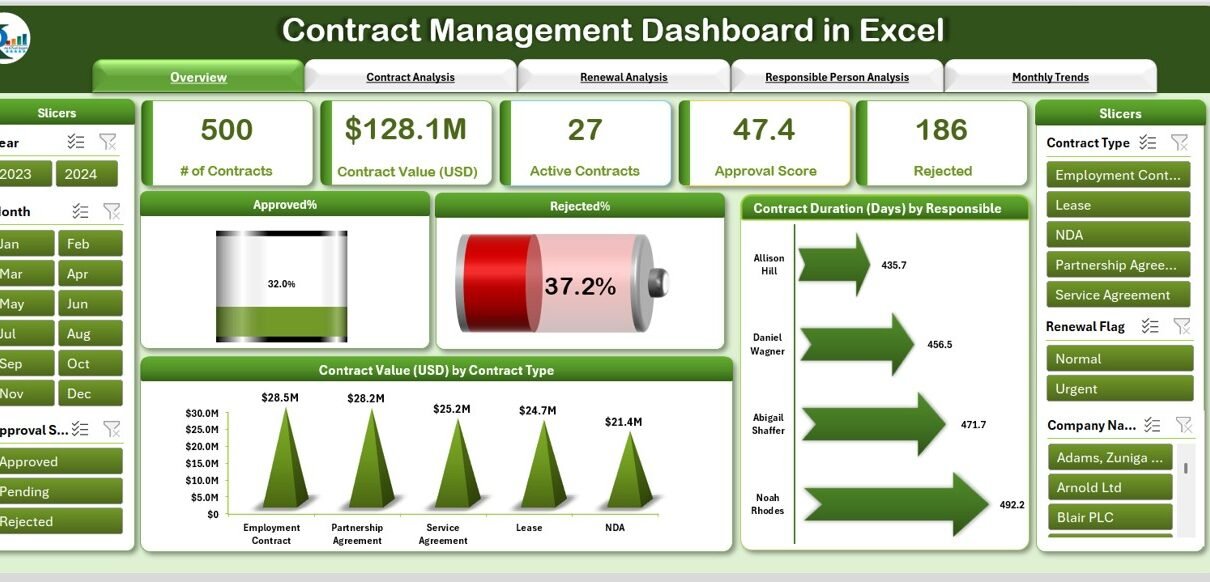In today’s fast-paced business environment, managing contracts efficiently is crucial for ensuring smooth operations and compliance. Whether you’re handling vendor agreements, client contracts, or internal policies, tracking key metrics and managing deadlines can be a daunting task. Fortunately, Excel provides a powerful tool that can simplify this process—Contract Management Dashboards.
In this article, we will delve into how a Contract Management Dashboard in Excel can help you streamline the entire contract lifecycle. We’ll explore its key features, advantages, best practices, and how to get started with this versatile template.
Click to Purchases Contract Management Dashboard in Excel
What is a Contract Management Dashboard in Excel?
A Contract Management Dashboard in Excel is a visual reporting tool that helps businesses track, manage, and analyze their contracts in a centralized location. This dashboard integrates multiple contract metrics into a single view, making it easier to monitor the status of contracts, key milestones, and responsible parties. It serves as a powerful tool for legal teams, procurement departments, and business managers who need to ensure compliance and mitigate risks associated with contract management.
The best part? It doesn’t require advanced software—Excel is enough to set up a functional and robust contract management system.
Key Features of the Contract Management Dashboard in Excel
The Contract Management Dashboard in Excel comes with a variety of features designed to help users gain insights into their contracts’ status and performance. Here’s an overview of its key features:
Page Navigator
The Page Navigator is located on the left side of the dashboard. It allows users to quickly navigate between different analytical pages, making the dashboard more user-friendly and accessible.
Overview Page
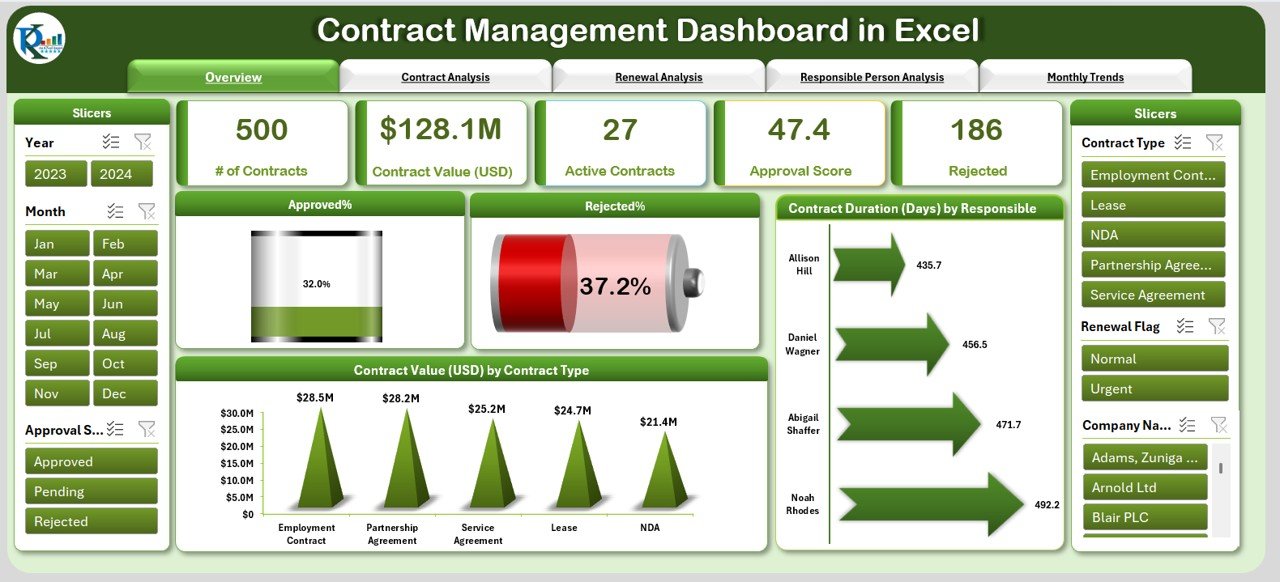
The Overview Page serves as the dashboard’s main page. It contains five interactive cards that provide a snapshot of your contract metrics, such as:
-
Approved %
-
Rejected %
-
Contract Duration (Days) by Responsible Party
-
Contract Value (USD) by Contract Type
This page also includes charts that offer a clear visual representation of the key metrics, enabling stakeholders to easily track and manage contract data.
Contract Analysis Page

The Contract Analysis Page breaks down the data by contract types. This page provides valuable insights with charts that display:
-
Number of Contracts by Contract Type
-
Active Contracts by Contract Type
-
Approved % by Contract Type
-
Rejected % by Contract Type
This analysis allows you to assess how different contract types are performing and helps identify any bottlenecks.
Renewal Analysis Page
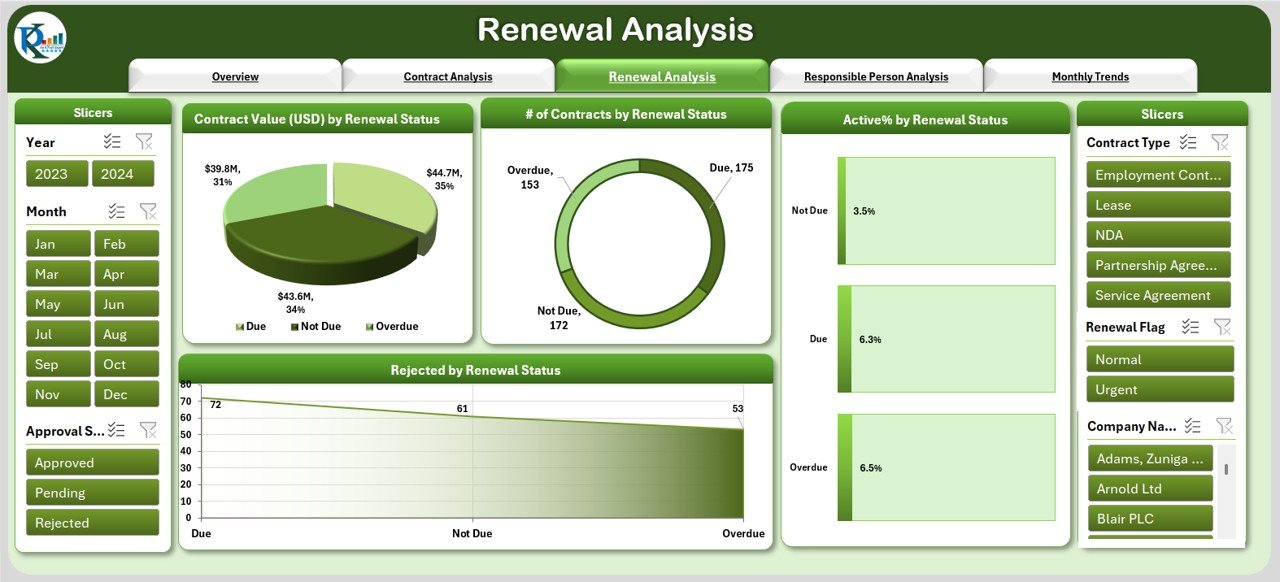
The Renewal Analysis Page is crucial for businesses that rely on recurring contracts. It helps track contract renewals by providing charts that show:
-
Contract Value (USD) by Renewal Status
-
Number of Contracts by Renewal Status
-
Active Contracts by Renewal Status
-
Rejected Contracts by Renewal Status
This page helps businesses stay on top of expiring contracts and manage renewal processes efficiently.
Click to Purchases Contract Management Dashboard in Excel
Responsible Person Analysis Page
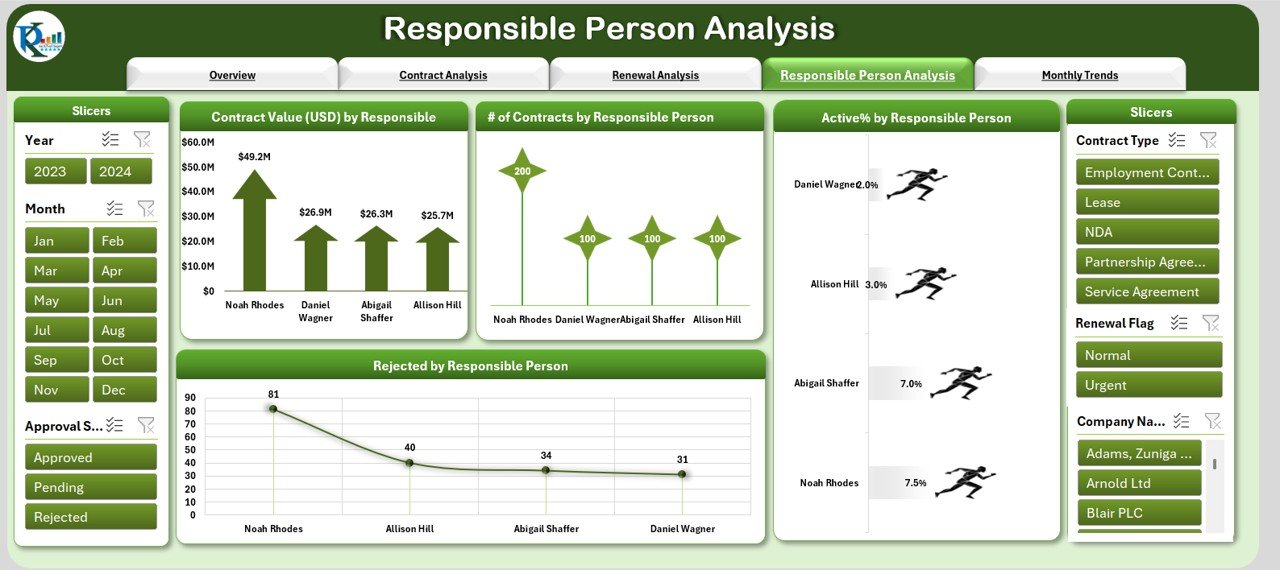
The Responsible Person Analysis Page helps you keep track of who is managing which contracts. This page includes charts that show:
-
Contract Value (USD) by Responsible Person
-
Number of Contracts by Responsible Person
-
Active Contracts by Responsible Person
-
Rejected Contracts by Responsible Person
This page helps ensure accountability and makes it easy to identify who is responsible for contract performance.
Monthly Trends Page
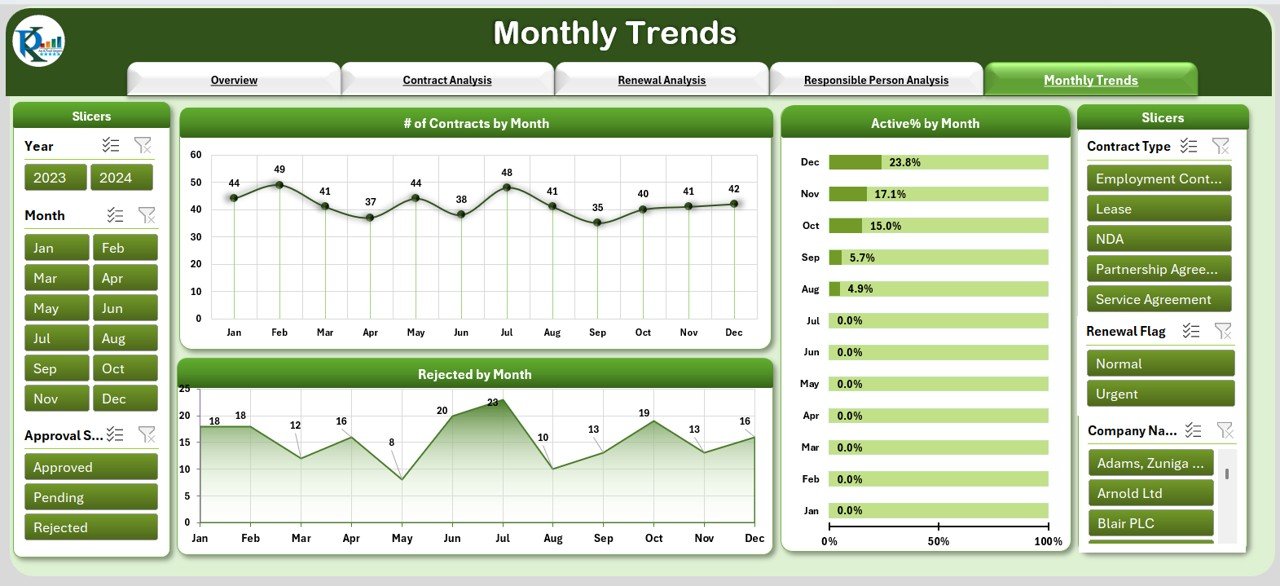
The Monthly Trends Page tracks contract activity over time, allowing businesses to identify patterns and trends in contract approval, rejection, and renewal. This page includes the following charts:
-
Number of Contracts by Month
-
Active % by Month
-
Rejected Contracts by Month
These trends help stakeholders stay proactive in managing the contract lifecycle and anticipate future workload.
Data Sheet
The Data Sheet contains all raw contract data, including contract details, dates, values, and responsible persons. This sheet serves as the foundation of the dashboard, feeding data into the various charts and analytics.
Support Sheet
The Support Sheet includes reference data that helps maintain the dashboard’s accuracy and integrity. It may contain a list of departments, contract types, or responsible personnel, ensuring consistency across the entire dashboard.
Advantages of Using a Contract Management Dashboard in Excel
Implementing a Contract Management Dashboard in Excel offers several advantages that can significantly improve your contract tracking and management process.
1. Centralized Data Management
By using a contract management dashboard, all contract data is stored in one place, making it easier to track and manage. This centralized approach eliminates the need for multiple systems and documents, reducing the risk of data inconsistencies.
2. Improved Decision-Making
The visual insights provided by the dashboard help stakeholders make data-driven decisions. Whether it’s identifying trends in contract renewals or pinpointing areas for improvement, the dashboard helps you make informed choices to optimize contract management.
3. Enhanced Efficiency
Automating contract tracking through Excel helps save time and reduces manual errors. By visualizing key metrics such as contract approvals, rejections, and renewals, the dashboard simplifies decision-making and allows you to focus on higher-priority tasks.
4. Better Collaboration
With all the data in one accessible dashboard, team members across departments (legal, procurement, finance) can collaborate more effectively. Everyone has access to the same information, ensuring alignment on contract statuses, deadlines, and responsibilities.
5. Risk Mitigation
The Contract Management Dashboard enables better risk management by providing clear visibility into contract expiration dates, renewal statuses, and compliance tracking. This proactive approach helps you identify potential risks early and address them before they become issues.
Best Practices for Contract Management Dashboards
To get the most out of your Contract Management Dashboard in Excel, it’s essential to follow best practices that ensure its effectiveness and usability.
1. Regularly Update Data
Ensure that the contract data in your dashboard is regularly updated. Stale data can lead to inaccurate analysis and poor decision-making. Set up a process for updating the data on a weekly or monthly basis.
2. Use Conditional Formatting
Leverage Excel’s conditional formatting to highlight important metrics, such as overdue contracts or approaching renewal deadlines. This will make it easier for users to spot urgent contracts and prioritize tasks accordingly.
3. Ensure Data Accuracy
Data accuracy is crucial for contract management. Ensure that the information entered into the dashboard is accurate and up to date. This will help you maintain the integrity of your analysis and decision-making.
4. Limit Access Based on Roles
To maintain security and confidentiality, limit access to the contract dashboard based on user roles. For instance, finance teams might only need access to contract value data, while legal teams may require access to contract terms and renewal statuses.
5. Customize for Your Business Needs
Every business has unique contract management needs. Customize the dashboard to track the metrics that matter most to your organization. This may include adding custom fields, adjusting the chart layout, or incorporating additional data sources.
Conclusion
A Contract Management Dashboard in Excel is a powerful tool for businesses looking to streamline their contract tracking and management processes. With its user-friendly interface and customizable features, Excel enables businesses to manage contracts more effectively, reduce risks, and make informed decisions. By utilizing best practices such as regular data updates and leveraging Excel’s features, you can unlock the full potential of this dashboard and ensure smooth contract operations.
Frequently Asked Questions (FAQs)
1. What are the key features of a Contract Management Dashboard in Excel?
The key features include a page navigator, overview page with key metrics, contract analysis, renewal analysis, responsible person analysis, monthly trends, and data and support sheets.
2. How does the dashboard help in contract renewal tracking?
The dashboard includes a Renewal Analysis Page that tracks contract value and status by renewal, helping businesses stay on top of expiring contracts and manage renewals effectively.
3. Can the dashboard be customized to track specific contract types?
Yes, the dashboard is highly customizable. You can adjust the chart layout, add custom fields, and modify metrics to suit your specific contract tracking needs.
4. Is this dashboard suitable for large enterprises?
Yes, the Contract Management Dashboard in Excel is scalable and can handle large volumes of contracts. It’s ideal for businesses of all sizes, from startups to large enterprises.
5. How often should I update the contract data in the dashboard?
It’s recommended to update the data regularly—at least once a week or monthly, depending on the volume of contracts being tracked. This ensures accurate and up-to-date information.
Visit our YouTube channel to learn step-by-step video tutorials
